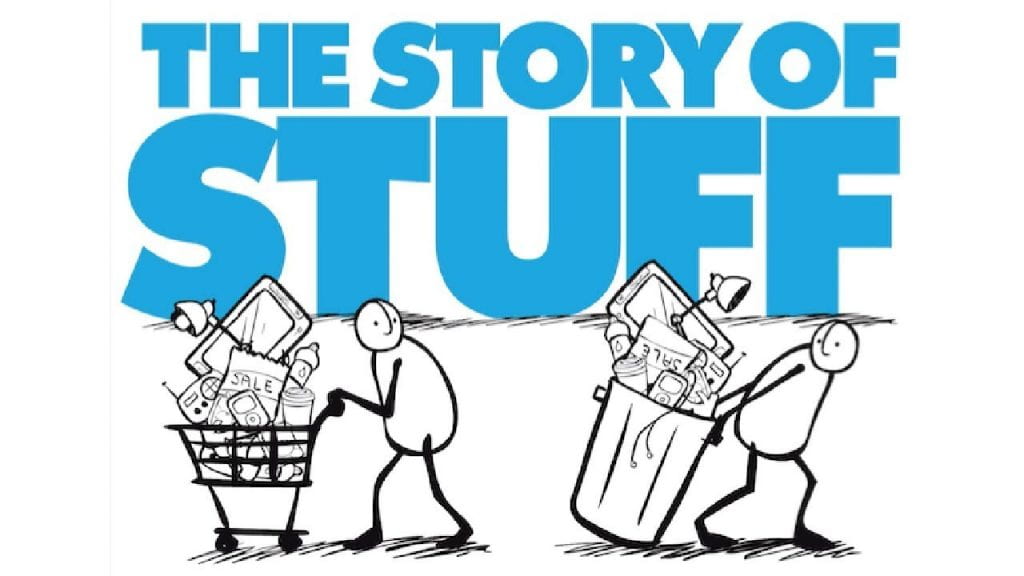In this digital age, it can be challenging to navigate the abundance of information that is available to us and to determine resources that are special and worth our time. We created Resource Digest to provide a diverse bank of resources that we here at the Office of Sustainability find enlightening and empowering. All of the featured resources will be handpicked and vetted!
In our first-ever resource feature, communications intern Selaam Dollisso presents The Story of Stuff Project, an over-a-decade long movement that is still growing to this day.
“From a movie to a movement.” This is what reads on the front page of the “Story of Stuff” website. At its heart, The Story of Stuff is about coming to the realization that we live in a consumption-crazed culture that is fundamentally unsustainable and harmful to both our planet and our wellbeing.
T his message is succinctly outlined by Story of Stuff’s 20-minute online movie, which was released in 2007 and became a viral success. In this groundbreaking video, founder of the Story of Stuff Annie Leonard, takes us through the linear system of our material economy, which goes from extraction, to production, to distribution, to consumption, and finally, to disposal. Using simple words, facts and a succession of black & white sketches, she demonstrates that our current system is broken and incompatible with our finite planet.
his message is succinctly outlined by Story of Stuff’s 20-minute online movie, which was released in 2007 and became a viral success. In this groundbreaking video, founder of the Story of Stuff Annie Leonard, takes us through the linear system of our material economy, which goes from extraction, to production, to distribution, to consumption, and finally, to disposal. Using simple words, facts and a succession of black & white sketches, she demonstrates that our current system is broken and incompatible with our finite planet.
Not only is our linear economy inherently wasteful, but the rate at which it generates waste has rapidly been increasing. Today, 99 percent of the stuff we harvest, mine, process, transport is trashed within 6 months. “How can we run a planet with that rate of materials throughput?” Leonard asks. And why do we do it in the first place? Is consuming more stuff making us more happy?
 While we have more stuff than ever before, polls actually show that national happiness in the U.S. is declining! And this is, according to Annie Leonard, because we have less and less time to spend doing things that we really care about. Instead, we work, shop and watch TV. “In the US, we spend 3 to 4 times as many hours shopping as our counterpart in Europe do!”.
While we have more stuff than ever before, polls actually show that national happiness in the U.S. is declining! And this is, according to Annie Leonard, because we have less and less time to spend doing things that we really care about. Instead, we work, shop and watch TV. “In the US, we spend 3 to 4 times as many hours shopping as our counterpart in Europe do!”.
As Americans, we have remained loyal to this linear cycle. Leonard explains how the corporations convinced us to participate in this endless consumption process.“Two of their most effective strategies are planned obsolescence and perceived obsolescence.” Planned obsolescence describes the creation of products that are essentially “designed for the dump”—they are designed to be useless as quickly as possible so we will chuck it and go buy a new one,” Leonard says. Everything from coffee cups to cameras is nowadays designed for planned obsolescence. On the other end, perceived obsolescence convinces us to throw away items that are still perfectly useful – it occurs when designers change the styling of products to decrease in the desirability of “unfashionable” items.
Aside from the important statistics in the video, Leonard propositions us to “reclaim and transform this linear system into something new, a system that doesn’t waste resources or people.” It is not something we have to just live with. We created the problem; therefore, we must create the solution.
Other Resources within the Story of Stuff website:
Today, the Story of Stuff website remains a valuable resource, with more videos, a blog, a podcast, a newsletter, and other learning tools. The resources below are highlights from the website, however there are even more resources which you can explore on their website here.
- Blog: Articles on relevant and timely topics, such as the Flint water crisis, why Starbucks may have missed the mark with its no-straw campaign, and more.
- More movies! The Story of Stuff Project has made many more movies since its first video. Most of the videos are presented in a similar fashion as the Story of Stuff animated video, however recent videos have begun to feature in-person interviews.
- The GoodSTUFF Newsletter (subscription): “Every month we’ll send you bite-sized chunks of positivity and educational content that will leave you feeling GOOD!” — The GoodSTUFF
- The Changemaker personality quiz: This short quiz tells you what kind of “changemaker” you are. I took the quiz myself and found out that I am an “Investigator.” Investigators do research and looking into issues thoroughly until the entire picture is clear, as well as asking hard questions and dark truths, although it may be uncomfortable or challenging. At the end of the quiz, you are able to see some famous people who match your change-making style. As it turns out, scientist and writer Rachel Carson is also an “Investigator”! I would say this quiz got me pretty right—I would love to be able to have such an impact as Carson has had.
Do you have an idea for the Resource Digest Series? We would love to hear it! Email the name of your resource and any other relevant details or links to sustainability@wustl.edu with “Resource Digest” in the subject line. Note: we will only select resources that are free and publicly accessible.
